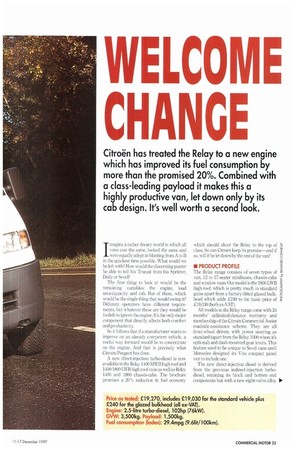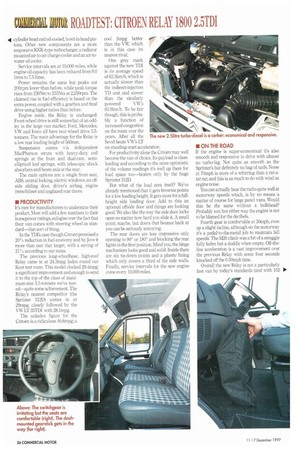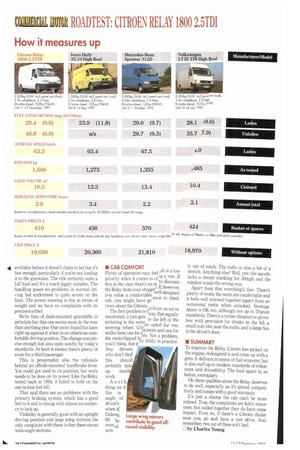011 LC01111 CHANGE
Page 27

Page 28

Page 30

If you've noticed an error in this article please click here to report it so we can fix it.
Citroen has treated the Relay to a new engine which has improved its fuel consumption by more than the promised 20%. Combined with a class-leading payload it makes this a highly productive van, let down only by its cab design. it's well worth a second look.
Imagine a rather dreary world in which all vans cost the same, looked the same and were equally adept at blasting from A to B in the quickest time possible. What would we be left with? How would the discerning punter be able to tell his Transit from his Sprinter, Daily or Sevel?
The first thing to look at would he the remaining variables: the engine, load area/capacity and cab. But of these, which would be the single thing that would swing it? Different operators have different requirements, hut whatever these are they would be foolish to ignore the engine. It's the only major component that directly affects both comfort and productivity.
So it follows that if a manufacturer wants to improve on an already competent vehicle, a useful way forward would be to concentrate on the engine. And that is precisely what Citroen/Peugeot has done.
A new direct-injection turbo-diesel is now available in the Relay 1400 N'IWB high-reaand 1400/1800 DNB high-roof vans as well as Relay 1400 and 1800 chassis-cabs. The brochure promises a 20% reduction in fuel economy which should shoot the Relay to the top of class. So can Citroen keep its promise—and if so, will it he let down by the rest of the van?
• PRODUCT PROFILE The Relay range consists of seven types of van, 12 to 17-seater minibuses, chassis-cabs and window vans. Our model is the 1800 LWB high-roof, which is pretty much in standard guise apart from a factory-fitted glazed bulkhead which adds £240 to the basic price of £19,030 (both ex-VAT).
All models in the Relay range come with 24 months' unlimited-distance warranty and membership of the Citroen Commercial Assist roadside-assistance scheme. They are all front-wheel driven, with power steering as standard (apart from the Relay 1000 where it's optional) and dash-mounted gear levers, This feature used to be unique to Sevel vans until Mercedes designed its Vito compact panel van to include one.
The new direct-injection diesel is derived from the previous indirect-injection turbodiesel, retaining its block and bottom end components but with a new eight-valve alloy 1110.
cylinder head and oil-cooled, bowl-in-head pistons. Other new components are a more responsive KKK-type turbocharger, a radiator mounted air-to-air charge-cooler and an air-towater oil cooler.
Service intervals are at 10,000 miles, while engine oil capacity has been reduced from 9.0 litres to 7.5 litres.
Power remains the same but peaks out 200rpm lower than before, while peak torque rises from 230Nm to 235Nm at 2,250rpm. The claimed rise in fuel efficiency is based on the extra power, coupled with a gearbox and final drive using higher ratios than before.
Engine aside, the Relay is unchanged. Front-wheel drive is still somewhat of an oddity in the large van market; Ford, Mercedes, VW and Iveco all have rear-wheel drive 3.5tonners. The main advantage for the Relay is a low rear loading height of 560mm.
Suspension comes via independent MacPherson struts with heavy-duty coil springs at the front and dual-rate. semielliptical leaf springs, with telescopic shock absorbers and beam axle at the rear.
The main options are: a single front seat, _ABS, central locking, electric windows, an offside sliding door, driver's airbag, engine immobiliser and unglazed rear doors.
• PRODUCTIVITY It's rare for manufacturers to understate their product. Most will add a few numbers to their horsepower ratings, eulogise over the fact that their van comes with steering wheel as standard—that sort of thing.
In the TDI's case though Citroen promised a 20% reduction in fuel economy and by Jove it more than met that target, with a saving of 21% according to our sums.
The previous long-wheelbase, high-roof Relay came in at 242mpg laden round our Kent test route. This model clocked 29.4mpg; a significant improvement and enough to send it to the top of the class of maximum-size 3.5-tonners we've tested—quite some achievement. The Relay's nearest competitor (the Sprinter 312D) comes in at 29mpg, closely followed by the VW LT 35TDI with 28.1mpg.
The unladen figure for the Citroen is a ridiculous 40.8mpg; a cool 5mpg better than the VW, which is in this case its nearest rival.
One grey mark against the new TDI is its average speed of 63.3km/h. which is actually slower than the indirect-injection TD unit and slower than the similarly powered VW's 65.9kmih. To be fair though, this is probably a function of increased congestion on the route over the years. After all the Sevel beats VW's LT on standing-start acceleration.
For productivity alone the Citroen may well become the van of choice. Its payload is classleading and according to the more optimistic of the volume readings it's well up there for load space too—beaten only by the huge Sprinter 312D.
But what of the load area itself? We've already mentioned that it gets brownie points for a low loading height. It gets more for a fullheight side loading door. Add to this an optional offside door and things are looking good. We also like the way the side door locks open no matter how hard you slide it A small point, maybe, but doors that bounce back at you can be seriously annoying.
The rear doors are less impressive only opening to 90° or 1800 and blocking the rear lights in the first position. Mind you, the hinge mechanism looks good and solid. Inside there are six tie-down points and a plastic lining which only covers a third of the side walls. Finally, service intervals for the new engine come every 10,000 miles.
• ON THE ROAD If the engine is super-economical it's also smooth and responsive to drive with almost no turbo-lag. Not quite as smooth as the Sprinter's but definitely no bag of nails. Noise at 70mph is more of a whirring than a rat-atat-tat; and this is as much to do with wind as engine noise.
You can actually hear the radio quite well at motorway speeds which, is by no means a matter of course for large panel vans. Would this be the same without a bulkhead? Probably not; but either way the engine is not to be blamed for the decibels.
Fourth gear is comfortable at 30mph, even up a slight incline, although on the motorway it's a pedal-to-the-metal job to maintain hill speeds. The M20 climb was a bit of a struggle fully laden but a doddle when empty. Off-theline acceleration is a vast improvement over the previous Relay with some four seconds knocked off the 0-50mph time.
Overall the new Relay is not a particularly fast van by today's standards (and with 102 ■ available horses it doesn't claim to be) but it's fast enough, particularly if you're not loading it to the gunwales. The ride certainly suits a full load and it's a touch jiggly unladen. The handling poses no problems in normal driving but understeer is quite severe on the limit. The power steering is fine in terms of weight and we have no complaints with its precision either.
We're fans of dash-mounted gearshifts in principle but this one seems more in the way than anything else. Our tester found his knee
right up against it when in an otherwise comfortable driving position. The change was pre
cise enough but also quite notchy by today's standards. At least it means there's plenty of room for a third passenger.
This is presumably also the rationale behind an offside-mounted handbrake lever.
You could get used to its position, but work needs to be done on its power. Like the Relay tested back in 1994, it failed to hold on the one-in-four test hill.
That said there are no problems with the primary braking system, which has a good feel to it and is strong with almost no tendency to lock up.
Visibility is generally good with an upright driving position and large wing mirrors; the only complaint with these is that there are no wide-angle sections.
• CAB COMFORT ab is a low Plenty of operators may feel ig a van. If priority when it comes to cFto discount this is the case there's no rfr.
however,
the Relay from your shoppiw' ell-designed you value a comfortable:ason to think cab, you might have go twice about the Citroen. a. lever: as we've The first problem is tiway. But equally mentioned, it just gets to the left of the irritating is the switsis_
opted for two
steering wheel. Citiicators and one for
stalks here; one for t No a Not problem,
the main/dipped 131v fiddly in practice.
you'd think, but ir Any drivers who don't find this should probably tak up needl work.
Anoth thing we d, like is angle of driver's when it: Unles-L 6ft 4r even.al_ arm
ly out of reach. The radio is also a bit of a stretch. Anything else? Well, yes: the speedo lacks a decent marking for 30mph and the window winds the wrong way
Apart from that everthing's fine. There's plenty of room, the seats are comfortable and it feels well screwed together (apart from an occasional rattle when unladen). Stowage space is OK too, although not up to Transit standards. There's a rather diminutive glovebox with provision for drinks in the lid; a small coin slot near the radio, and a large bin in the driver's door.
• SUMMARY
To improve the Relay, Citroen has picked on the engine, redesigned it and come up with a gem. It delivers in terms of fuel economy but is also well up to modern standards of refinement and driveability. The load space is, as before, exemplary.
On these qualities alone the Relay deserves to do well, especially as it's priced competitively and comes with a good warranty. It's just a shame the cab can't be more refined. True, the complaints are fairly minor ones, but added together they do have some impact. Even so, if there's a Citroen dealer near you, go and have a test drive. And remember, two out of three ain't bad.
by Charles Young
















































































































